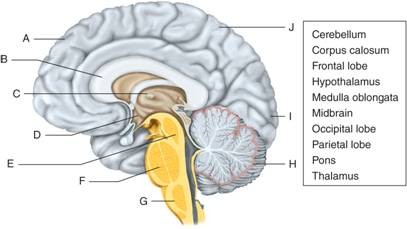 Letter G in the figure refers to the ________, which controls heart rate, blood pressure, and respiration, as well as several reflexes.
Letter G in the figure refers to the ________, which controls heart rate, blood pressure, and respiration, as well as several reflexes.
Fill in the blank(s) with the appropriate word(s).
medulla oblongata
The medulla oblongata controls heart rate, blood pressure, and respiration, as well as reflexes associated with coughing, sneezing, and vomiting.
You might also like to view...
The wife of a 43-year-old male has called 911 because her husband was difficult to wake up and now is lethargic with garbled speech. She reports a history of diabetes, stroke, renal failure, and high blood pressure. His airway is patent, respirations tachypneic but adequate, and radial pulse rapid. Your partner reports the following vital signs: pulse 136, respirations 22, blood pressure 106/62,
SpO2 at 92%, and blood glucose 642. Which one of the following would be most appropriate in the care of this patient? A) Administer supplemental oxygen. B) Administer oral glucose. C) Encourage the patient to drink water. D) Assist the patient with his insulin.
Which of the following is an advantage of cryogenic liquids?
A. Low liquid-to-vapor ratio B. Extremely low temperatures C. Valuable because they are hot D. Ability to modify a material's liquid-to-gas volume ratio
In a hospital setting, which of the following professionals is expressly charged by the hospital administration with being directly responsible for the execution, enforcement, and maintenance of the ALARA program?
a. Assistant administrator of the facility b. Chief of staff c. Radiation Safety Officer d. Student radiologic technologist
Applying a tourniquet is the most effective way to control bleeding
Indicate whether the statement is true or false